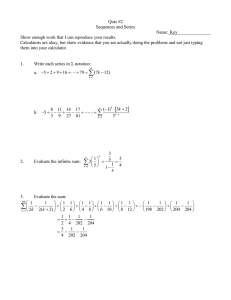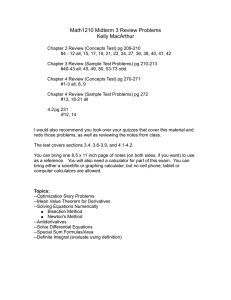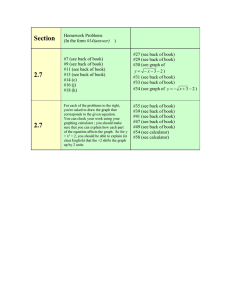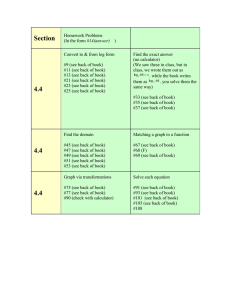Calculator Policy - Ministry of Education
advertisement
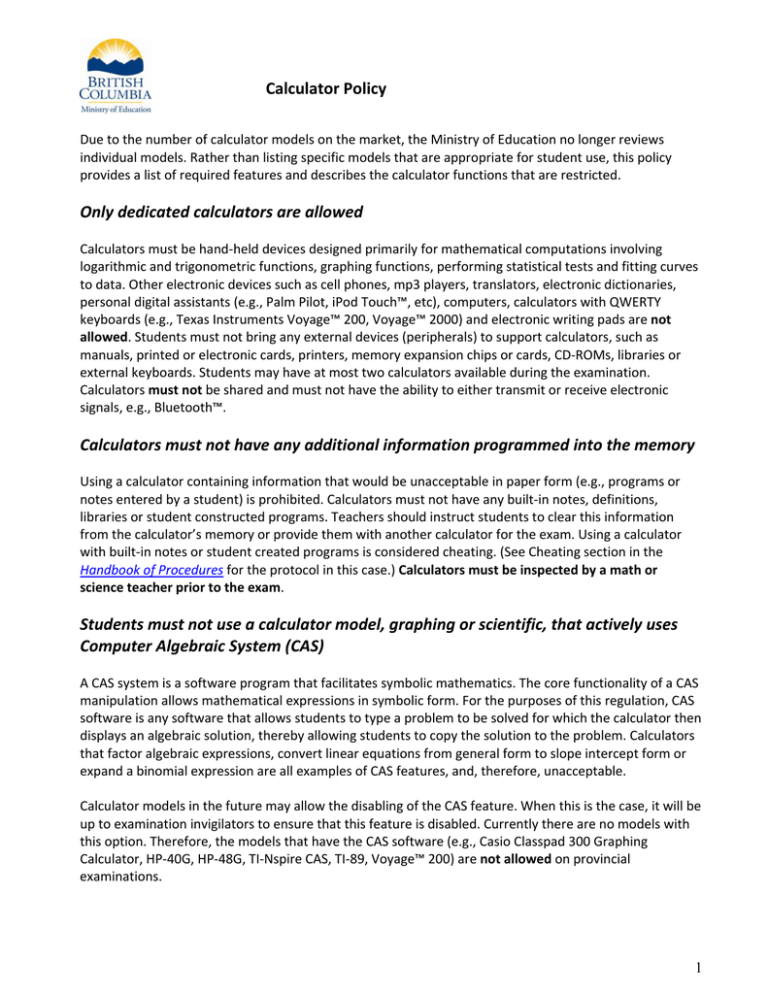
Calculator Policy Due to the number of calculator models on the market, the Ministry of Education no longer reviews individual models. Rather than listing specific models that are appropriate for student use, this policy provides a list of required features and describes the calculator functions that are restricted. Only dedicated calculators are allowed Calculators must be hand‐held devices designed primarily for mathematical computations involving logarithmic and trigonometric functions, graphing functions, performing statistical tests and fitting curves to data. Other electronic devices such as cell phones, mp3 players, translators, electronic dictionaries, personal digital assistants (e.g., Palm Pilot, iPod Touch™, etc), computers, calculators with QWERTY keyboards (e.g., Texas Instruments Voyage™ 200, Voyage™ 2000) and electronic writing pads are not allowed. Students must not bring any external devices (peripherals) to support calculators, such as manuals, printed or electronic cards, printers, memory expansion chips or cards, CD‐ROMs, libraries or external keyboards. Students may have at most two calculators available during the examination. Calculators must not be shared and must not have the ability to either transmit or receive electronic signals, e.g., Bluetooth™. Calculators must not have any additional information programmed into the memory Using a calculator containing information that would be unacceptable in paper form (e.g., programs or notes entered by a student) is prohibited. Calculators must not have any built‐in notes, definitions, libraries or student constructed programs. Teachers should instruct students to clear this information from the calculator’s memory or provide them with another calculator for the exam. Using a calculator with built‐in notes or student created programs is considered cheating. (See Cheating section in the Handbook of Procedures for the protocol in this case.) Calculators must be inspected by a math or science teacher prior to the exam. Students must not use a calculator model, graphing or scientific, that actively uses Computer Algebraic System (CAS) A CAS system is a software program that facilitates symbolic mathematics. The core functionality of a CAS manipulation allows mathematical expressions in symbolic form. For the purposes of this regulation, CAS software is any software that allows students to type a problem to be solved for which the calculator then displays an algebraic solution, thereby allowing students to copy the solution to the problem. Calculators that factor algebraic expressions, convert linear equations from general form to slope intercept form or expand a binomial expression are all examples of CAS features, and, therefore, unacceptable. Calculator models in the future may allow the disabling of the CAS feature. When this is the case, it will be up to examination invigilators to ensure that this feature is disabled. Currently there are no models with this option. Therefore, the models that have the CAS software (e.g., Casio Classpad 300 Graphing Calculator, HP‐40G, HP‐48G, TI‐Nspire CAS, TI‐89, Voyage™ 200) are not allowed on provincial examinations. 1 Required Calculators Students are required to have a calculator to answer some of the questions on the following examinations. The table indicates the type of calculator required by examination. Provincial Examination Apprenticeship and Workplace Mathematics 10 Foundations of Mathematics and Pre‐Calculus 10 Science 10 Type of Calculator Required Scientific Scientific Scientific Each course and examination has different requirements that reflect the nature of the course. Students should consult with their subject area teachers before purchasing calculators to confirm what specific functions are required. The following table is presented to help teachers, parents and students determine the calculator that best fits the program of studies in which students are enrolled. Provincial Examination Apprenticeship and Workplace Mathematics 10 Required Features Simple addition, subtraction, multiplication and division; operations with exponents, roots and trigonometric functions. Note: A two‐line display feature is useful but not required. Foundations of Mathematics Simple addition, subtraction, multiplication and division; and Pre‐Calculus 10 operations with exponents, roots and trigonometric functions. Note: A two‐line display feature is useful but not required. Science 10 Simple addition, subtraction, multiplication and division. Regardless of the required features and type of calculator, students are only allowed to use calculators that meet the requirements stated on page 1. 2
